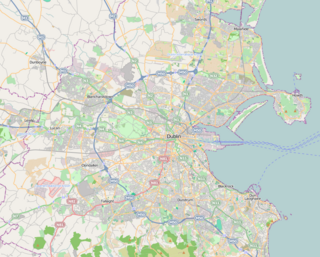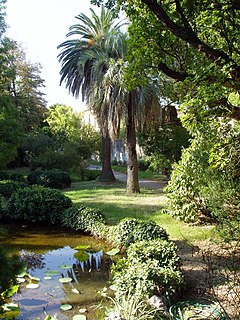Related Research Articles

The National Botanic Gardens is a botanical garden in Glasnevin, 5 km north-west of Dublin city centre, Ireland. The 19.5 hectares are situated between Glasnevin Cemetery and the River Tolka where it forms part of the river's floodplain.

The Royal Horticultural Society (RHS), founded in 1804 as the Horticultural Society of London, is the UK's leading gardening charity.

A botanical garden or botanic garden is a garden dedicated to the collection, cultivation, preservation and display of a wide range of plants labelled with their botanical names. It may contain specialist plant collections such as cacti and other succulent plants, herb gardens, plants from particular parts of the world, and so on; there may be greenhouses, shadehouses, again with special collections such as tropical plants, alpine plants, or other exotic plants. Visitor services at a botanical garden might include tours, educational displays, art exhibitions, book rooms, open-air theatrical and musical performances, and other entertainment.
Plant Heritage, formerly known as the National Council for the Conservation of Plants and Gardens (NCCPG), is a botanical conservation organisation in the United Kingdom and a registered charity. It was founded in 1978 to combine the talents of botanists, horticulturalists and conservationists with the dedication of keen amateur and professional gardeners. The mission statement of the organisation declares that "The NCCPG seeks to conserve, document, promote and make available Britain and Ireland's rich biodiversity of garden plants for the benefit of everyone through horticulture, education and science." Specifically, the aims of the organisation are to:

The Royal Botanic Garden Edinburgh (RBGE) is a scientific centre for the study of plants, their diversity and conservation, as well as a popular tourist attraction. Founded in 1670 as a physic garden to grow medicinal plants, today it occupies four sites across Scotland—Edinburgh, Dawyck, Logan and Benmore—each with its own specialist collection. The RBGE's living collection consists of more than 13,302 plant species, whilst the herbarium contains in excess of 3 million preserved specimens.

Sir Robert Sibbald was a Scottish physician and antiquary.

Ulmus laevisPall., variously known as the European white elm, fluttering elm, spreading elm, stately elm and, in the United States, the Russian elm, is a large deciduous tree native to Europe, from France northeast to southern Finland, east beyond the Urals into Kyrgyzstan and Kazakhstan, and southeast to Bulgaria and the Crimea; there are also disjunct populations in the Caucasus and Spain, the latter now considered a relict population rather than an introduction by man, and possibly the origin of the European population. U. laevis is rare in the UK, although its random distribution, together with the absence of any record of its introduction, has led at least one British authority to consider it native. NB: The epithet 'white' elm commonly used by British foresters alluded to the timber of the wych elm.

Ulmus davidiana var. japonica, the Japanese elm, is one of the larger and more graceful Asiatic elms, endemic to much of continental northeast Asia and Japan, where it grows in swamp forest on young alluvial soils, although much of this habitat has now been lost to intensive rice cultivation.
The Victoria Medal of Honour (VMH) is awarded to British horticulturists resident in the United Kingdom whom the Royal Horticultural Society Council considers deserving of special honour by the Society.

Ulmus 'Regal' is an American hybrid elm cultivar developed by the University of Wisconsin–Madison and released in 1983. 'Regal' was derived from seeds arising from the crossing of the Dutch hybrid clones 'Commelin' and '215' sent in 1960 by Hans M. Heybroek of the Dorschkamp Research Institute for Forestry & Landscape Planning, Wageningen, Netherlands.

The hybrid elm cultivar Ulmus × hollandica 'Dampieri', one of a number of cultivars arising from the crossing of the Wych Elm U. glabra with a variety of Field Elm U. minor, is believed to have originated in continental Europe. It was marketed in Wetteren, Belgium, in 1851 as 'Orme de Dampier', then in the Low Countries in 1853, and later identified as Ulmus campestris var. nuda subvar. fastigiata DampieriHort., Vilv. by Wesmael (1862).

The hybrid elm cultivar Ulmus × hollandica 'Wredei', also known as Ulmus × hollandica 'Dampieri Aurea' and sometimes marketed as Golden Elm, originated as a sport of the cultivar 'Dampieri' at the Alt-Geltow Arboretum, near Potsdam, Germany, in 1875.

The elm cultivar Ulmus 'Scampstoniensis', the Scampston Elm or Scampston Weeping Elm, is said to have come from Scampston Hall, Yorkshire, England, before 1810. Loudon opined that a tree of the same name at the Royal Horticultural Society's Garden in 1834, 18 feet (5.5 m) high at 8 years old "differed little from the species". Henry described the tree, from a specimen growing in Victoria Park, Bath, as "a weeping form of U. nitens" [:Ulmus minor ]; however Green considered it "probably a form of Ulmus × hollandica". Writing in 1831, Loudon said that the tree was supposed to have originated in America. U. minor is not, however, an American species, so if the tree was brought from America, it must originally have been taken there from Europe. There was an 'American Plantation' at Scampston, which may be related to this supposition. A number of old specimens of 'Scampstoniensis' in this plantation were blown down in a great gale of October 1881; younger specimens were still present at Scampston in 1911.

Botanic Gardens Conservation International (BGCI) is a plant conservation charity based in Kew, London, England. It is a membership organisation, working with 800 botanic gardens in 118 countries, whose combined work forms the world's largest plant conservation network.

Ulmus parvifolia, commonly known as the Chinese elm or lacebark elm, is a species native to eastern Asia, including mainland China, Taiwan, Japan, North Korea, South Korea and Vietnam. It has been described as "one of the most splendid elms, having the poise of a graceful Nothofagus".
The Oman Botanic Garden is a development of the Diwan of Royal Court in Oman, growing unique plants, landscapes and covering cultural traditions of Oman. The garden is currently under construction. When it opens it will showcase all of the native plant species of Oman in a series of created, naturalistic habitats from the dry deserts to the rich monsoon cloud forests. The garden will also showcase the traditionally cultivated crops and the many ways that people use plants in Oman.
Noel Farnie Robertson (1923–1999) was a Scottish botanist and agriculturist who was elected a Fellow of the Royal Society of Edinburgh (FRSE).

William A. McNamara is an American horticulturist and expert in the field of plant conservation and the flora of Asia. Now retired, he was the President and Executive Director of Quarryhill Botanical Garden, a 25-acre wild woodland garden in Northern California's Sonoma Valley featuring wild-sourced plants from temperate East Asia. In 2017, he and Quarryhill Botanical Garden celebrated their 30th Anniversary. He retired from the Garden in October of 2019.
Rosemary Margaret Smith (1933–2004) was a Scottish botanist and illustrator who specialized in the taxonomy of the Zingiberaceae, or ginger family. Many of the species she classified and identified as being placed into improper genera were found in Asian countries, especially in the isolated island of Borneo.
Sibbaldia: the International Journal of Botanic Garden Horticulture is an online journal which publishes "peer-reviewed articles and short notes on the cultivation, conservation, research, botany, history, landscaping, legislation, management, and curation of plants in botanic and other gardens." It was first published in 2003.
References
- ↑ "PlantNetwork Conferences". The Horticulturist. 2004. p. 23. Retrieved January 11, 2021.
- ↑ Tilley, Jonathan (July 6, 2011). "PlantNetwork conference looks at volunteers in gardens and arboreta". Horticulture Week . Retrieved January 11, 2021.
- ↑ Cosgrove, Sarah (August 22, 2014). "Royal Botanic Garden Edinburgh horticulture head Dr David Rae set to retire". Horticulture Week . Retrieved January 11, 2021.
- ↑ Bird, Chris (2014). The Fundamentals of Horticulture: Theory and Practice. Cambridge University Press. p. 17. ISBN 9781107782549.
- ↑ Toomer, Simon (2010). Planting and Maintaining a Tree Collection. Timber Press. p. 169-170. ISBN 9780881929300.
- ↑ "The Sibbaldia and PlantNetwork Conference". BGCI.org. Botanic Gardens Conservation International. 2020. Retrieved January 9, 2021.
- ↑ Symonds, Dan (December 23, 2019). "Bursaries made available for young attendees at Edinburgh horticultural conference". Horticulture Week . Retrieved January 9, 2021.